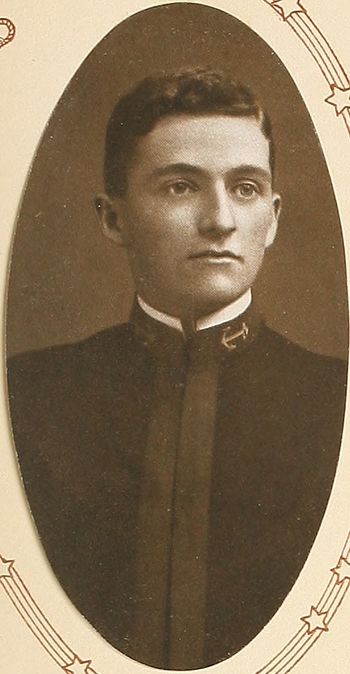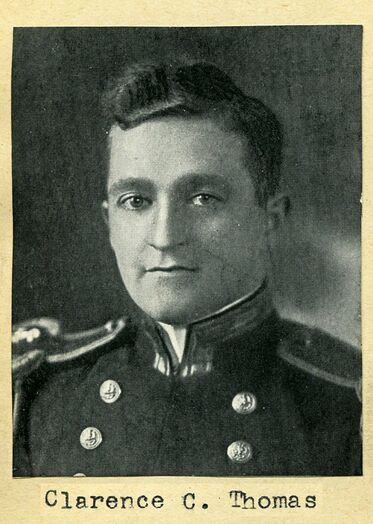CLARENCE C. THOMAS, LT, USN
Clarence Thomas '08
Lucky Bag
From the 1908 Lucky Bag:
CLARENCE CRASE THOMAS
Grass Valley, California
"Tommy"
A little man with a whole lot of nerve. Has the distinction of having once bluffed out Plug. Decidedly a non-greaser. One of the steady Red Mikes. Very fixed in his opinions; having once decided on a thing, sticks to it. Fond of a good old rough-house, and when not engaged in this gentle pastime may usually be found playing cards with Tip.

CLARENCE CRASE THOMAS
Grass Valley, California
"Tommy"
A little man with a whole lot of nerve. Has the distinction of having once bluffed out Plug. Decidedly a non-greaser. One of the steady Red Mikes. Very fixed in his opinions; having once decided on a thing, sticks to it. Fond of a good old rough-house, and when not engaged in this gentle pastime may usually be found playing cards with Tip.
Loss
Clarence was killed in action when the merchant steamship SS Vacuum was torpedoed by a German submarine on April 28, 1917. He was in charge of the vessel's naval guard.
Other Information
From researcher Kathy Franz:
Clarence graduated from the local high school.
He married Ruth Evelyn Martin on July 2, 1913, at St. Anne's Protestant Episcopal Church in Grass Valley. Her sister was Mrs. Thales S. Boyd ('12).
The Log published tributes to Clarence's life and a half-tone portrait in its issue of May 11, 1917.
Clarence's father John M. worked at the Citizens Bank in Grass Valley.
From Wikipedia:
Born in Grass Valley, California, Thomas was appointed midshipman on July 7, 1904 and graduated from the United States Naval Academy on June 5, 1908. After service in armored cruiser USS Maryland (ACR-8) and gunboat USS Yorktown (PG-1), he was commissioned ensign on June 29, 1910.
In the next few years, Thomas served on USS Denver (C-14), USS Cleveland (C-19), and USS West Virginia (ACR-5).
Appointed lieutenant (j.g.) on June 26, 1913, he was detached from West Virginia in the summer of 1914 to attend a post-graduate course in steam engineering at the Naval Academy. He attended Columbia University in late 1915 and, on June 24, 1916, reported on board USS Florida (BM-9) as her electrical officer.
Thomas was commissioned lieutenant on January 8, 1917 and was placed in charge of the naval armed guard on the merchant steamship SS Vacuum in April. On the 28th, when a lookout reported sighting a German submarine, some 120 miles west of the Hebrides Islands, Lt. Thomas went to the ship's after gun. A few moments later, a torpedo from U-21 struck Vacuum, and exploded, throwing Thomas and the gun's crew into the water. The ship sank within two minutes. Picked up by a boat, Thomas soon died of cold and exposure.
He was the first United States naval officer to lose his life in the war with Germany and was posthumously awarded the Navy Cross "for distinguished service in the line of his profession as commander of the armed guard crew of the ... Vacuum."
Richard was survived by his wife, Evelyn; she later married H.B. Kelly '06, who died in 1942, and Francis Traynor '10. (Information from June 1975 issue of Shipmate.) Richard was also survived by two of his brothers; he has a memory marker in England and another at the Naval Academy Cemetery.
Remembrances
From Capital Gazette (Annapolis) on April 28, 2017:
He was one of 116,516 Americans who fell during the carnage of the Great War.
But Lt. Clarence Crase Thomas' sacrifice was one of the first and signified America had entered a war watched from the sidelines for three years.
Friday marked the 100th anniversary of the death of Thomas, a Naval Academy graduate who was the first U.S. naval officer to die in World War I. Buried at the academy, there was no fanfare to mark the centennial of his death. Yet the nation's entry into the war on April 2, 1917 and Thomas' death marked the start of lasting changes for both the country and the Naval Academy.
Thomas was born on Dec. 26, 1886 in Grass Valley, California, a town 50 miles north of Sacramento that was one to one of the richest gold mines in the state. He came to Annapolis as Naval Academy plebe at age 17 in 1904 and graduated from the academy four years later. After serving as a Naval cadet for two years, Thomas was commissioned as an ensign in 1910 — a norm that would soon change after the war.
He was stationed on several battleships and took post-graduate classes at the Naval Academy and Columbia University, allowing him to work his way up the ranks. And while the U.S.' relationship with Germany became more strained, Thomas was promoted to lieutenant.
Two weeks before the United States declared war on Germany, the lieutenant took command of the naval guard on the merchant steamship SS Vacuum, according Naval History and Heritage Command's website.
On the night Thomas died, one of the ship's lookouts saw a German submarine about 120 miles west of the Hebrides Islands. When hearing the news, Thomas reportedly went to the ship's after gun, according Naval History and Heritage Command. Just moments later, a torpedo from the German submarine U-21 hit Vacuum. The explosion threw Thomas and the gun's crew into the water.
The ship sank within two minutes. The crew was picked up by another boat. Thomas, who was 30 at the time, died shortly after being rescued from exposure.
He was posthumously awarded the Navy Cross for "distinguished service in the line of his profession as commander of the armed guard crew" of the Vacuum. The destroyer USS Thomas was named after him in July 1918. It would be the first of several ships named after him.
Thomas was one of the 13 academy graduates who were killed in action during World War I, said James Cheevers, senior curator at the Naval Academy Museum. The years leading up to the war, and the war itself, "very dramatically" affected the academy, he said.
One of the biggest — and most notable — impacts was the increase in midshipmen. The academy population increased by 300 percent during the war, Cheevers said.
To remain competitive during the arms race between Germany and Great Britain before the war, the United States was creating bigger and bigger battleships — which required increasing numbers of men. Early battleships, Cheevers said, required about 40 officers and 500 sailors. By the start of the war, that number had grown to 60 officers and about 1,100 sailors.
In 1916, just one year before the United States entered the war, Congress voted to increase the midshipmen population, called "the regiment" at the time, from 1,400 to 1,800.
The population on the yard grew even more during the war when the academy set up a temporary reserve officer's school to more than 2,500 people to teach them how to operate ships and submarines. Because of this, the academy physically expanded during the war, Cheevers said. The 5th and 6th wings of Bancroft Hall, the mids dorm, were added during this time and are still called the "WWI wings," he said.
The academy graduated several classes early in order to prepare for the war, Cheevers said. The Class of 1917 graduated that March, instead of June, and the Class of 1918 graduated in June of 1917. Congress then temporarily changed the academy from a four-year to a three-year school until around 1921.
This was common during the Civil War and the Spanish-American War, he said, but World War I was the first time the academy adapted its curriculum instead of eliminating a full school year. The academy dropped its junior year and took the courses taught to sophomores and moved them to freshmen year. The academy would follow this curriculum during World War II.
Not surprisingly, the culture at the academy changed during the war. The superintendent closed the yard to visitors and canceled all athletic events and dances, known as "hops" at the time, Cheevers said. And yes, that included the Army-Navy football game. It was canceled in 1917 and 1918.
To the anger of local Annapolis residents, the secretary of the navy signed an order in 1918 that banned the sale, serving or transport of alcohol within five miles of a naval installation. The ban of alcohol continued through Prohibition and prevented the development and expansion of restaurants in the city, Cheevers said.
The tradition of midshipmen throwing their covers – hats to civilians – was also born in the years leading up to the war.
Until 1912, midshipmen were required to serve as naval cadets for two years after graduation in order to be promoted to ensign or second lieutenant. But Congress decided to speed up the process and give mids their diploma and commission at graduation. Since they no longer needed their midshipmen covers, the newly commissioned officers started throw them up in the air in celebration, Cheevers said.
And following the academy, most of the graduates headed to the Atlantic fleet to fight the Germans.
"That's where the action was," Cheevers said.
Photographs
From Hall of Valor:
The President of the United States of America takes pride in presenting the Navy Cross (Posthumously) to Lieutenant Clarence Crase Thomas, United States Navy, for exceptionally meritorious service in Command of the Armed Guard of the S.S. VACUUM, when that ship was torpedoed about 10.30 a. m. 28 April 1917. The ship started sinking so fast it was impracticable to open fire, and all hands took to boats. Lieutenant Thomas died from exposure in an open boat. It is believed that Lieutenant Thomas was first officer lost in the war.
Service: Navy
Division: S.S. Vacuum
The "Register of Commissioned and Warrant Officers of the United States Navy and Marine Corps" was published annually from 1815 through at least the 1970s; it provided rank, command or station, and occasionally billet until the beginning of World War II when command/station was no longer included. Scanned copies were reviewed and data entered from the mid-1840s through 1922, when more-frequent Navy Directories were available.
The Navy Directory was a publication that provided information on the command, billet, and rank of every active and retired naval officer. Single editions have been found online from January 1915 and March 1918, and then from three to six editions per year from 1923 through 1940; the final edition is from April 1941.
The entries in both series of documents are sometimes cryptic and confusing. They are often inconsistent, even within an edition, with the name of commands; this is especially true for aviation squadrons in the 1920s and early 1930s.
Alumni listed at the same command may or may not have had significant interactions; they could have shared a stateroom or workspace, stood many hours of watch together… or, especially at the larger commands, they might not have known each other at all. The information provides the opportunity to draw connections that are otherwise invisible, though, and gives a fuller view of the professional experiences of these alumni in Memorial Hall.
January 1911
January 1912
January 1913
January 1914
January 1915
January 1916
January 1917
Namesake
USS Thomas (DD 182) was named for Clarence; the ship was sponsored by his widow, Evelyn; USS Thomas (DE 102) was also named for him.

The "category" links below lead to lists of related Honorees; use them to explore further the service and sacrifice of alumni in Memorial Hall.
